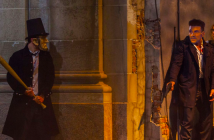
Editor’s Note: The Purge: Election year opens in wide theatrical release today, July 1, 2016.
This is the way the world (almost) ends, not with a bang, but with an election, an election pitting a sane, reasonable, humane centrist against a vicious, fundamentalist extremist. No, we’re not talking about the upcoming November election in the United States of America, but the latest entry in the ongoing Purge series, The Purge: Election Year. Turning our worst fears and anxieties about a fascist, authoritarian takeover via typically democratic means (i.e., the analog or virtual ballot box), the Purge series posits a bleak, grim near future where a yearly social ritual, the so-called “Purge” of the title, permits any violent excess or crime imaginable, including murder, for a 12-hour period free of reprisal or prosecution, The ritual supposedly functions as a cathartic means to minimize violence throughout the remainder of the year, but in fact serves as a thinly disguised exercise in class warfare (i.e., the rich vs. the poor).
Ultra-violence is always around the corner, sometimes literally, in the Purge universe, and DeMonaco, working with a slightly higher budget this time, doesn’t shy away from giving audiences the exploitation-level goods they want…
While the “Purge” provides an undoubtedly arresting, fascinating premise, it doesn’t survive close scrutiny. Human nature and social behavior in the real world bear little if any resemblance to what James DeMonaco suggests in the “Purge” series. Logic and rationality, however, are, at best, tangential to DeMonaco’s ever expanding plan for the series. The first film, The Purge, hinted at broader contemporary concerns underneath a relatively straightforward home-invasion thriller. The commercial success of The Purge: Anarchy gave DeMonaco the opportunity to give us a glimpse of the Purge itself, placing a random group of ill-fated strangers against the might of the New Founding Fathers of America and their hidden agenda of culling the population to minimize spending on social services. With The Purge: Election Year, DeMonaco switches gears again, turning the series into the equivalent of a buddy-cop thriller, with The Purge: Anarchy’s lone holdover, Leo Barnes (Frank Grillo), playing protector to Charlene “Charlie” Roan (Elizabeth Mitchell), a U.S. senator running for the presidency on a platform of eliminating the Purge permanently.
 Roan’s position puts her squarely in the gun sites of the New Founding Fathers. They want to protect their wealth, power, and social status and will do anything to ensure Roan doesn’t make it to election day, including sending a merc team to assassinate her during the Purge. Only Barnes and Roan survive the attack, forcing them out into the Washington, D.C. streets and the mercy and/or kindness of strangers. DeMonaco introduces another intriguing idea, “murder tourism” (European tourists venture to the U.S. on Purge night for murder and mayhem), but soon drops the idea – typical for DeMonaco and the series – for another straight ahead survival thriller. Eventually, Roan and Barnes come across strangers, Joe Dixon (Mykelti Williamson), Marcos (Joseph Julian Soria), and Laney (Betty Gabriel), who agree to help Roan make it through Purge night. Luckily, they’re already onboard with Roan’s plan to abolish the Purge permanently.
Roan’s position puts her squarely in the gun sites of the New Founding Fathers. They want to protect their wealth, power, and social status and will do anything to ensure Roan doesn’t make it to election day, including sending a merc team to assassinate her during the Purge. Only Barnes and Roan survive the attack, forcing them out into the Washington, D.C. streets and the mercy and/or kindness of strangers. DeMonaco introduces another intriguing idea, “murder tourism” (European tourists venture to the U.S. on Purge night for murder and mayhem), but soon drops the idea – typical for DeMonaco and the series – for another straight ahead survival thriller. Eventually, Roan and Barnes come across strangers, Joe Dixon (Mykelti Williamson), Marcos (Joseph Julian Soria), and Laney (Betty Gabriel), who agree to help Roan make it through Purge night. Luckily, they’re already onboard with Roan’s plan to abolish the Purge permanently.
While the “Purge” provides an undoubtedly arresting, fascinating premise, it doesn’t survive close scrutiny.
DeMonaco writes Dixon as a relatively simple, decent man, initially more concerned with protecting his convenience store against looters than taking a stand for or against anything. But people eventually trump property and Dixon relents, proving himself Barnes’ near equal with a firearm. DeMonaco makes Marcos an example of the hardworking, dedicated immigrant turned U.S. citizen. He’s willing to sacrifice himself to stand with Dixon and later Roan and Barnes. Laney represents something a bit murkier, a onetime Purger who’s turned away from the Purge to help those in need on Purge night. DeMonaco doesn’t go for depth character wise, but to his credit, makes heroes of them all while the villains personify white entitlement and privilege taken to the logical (or illogical) extreme. Then again, ultra-violence is always around the corner, sometimes literally, in the Purge universe, and DeMonaco, working with a slightly higher budget this time, doesn’t shy away from giving audiences the exploitation-level goods they want more than any political theorizing or sermonizing DeMonaco wants to impart, albeit via shaky cam that diminishes its effectiveness over the course of The Purge: Election Year’s 1 hour, 45-minute running time.
The Purge series is extremely crude and reductive, of course, but that’s also inherent in genre, especially genres like horror and – to a lesser extent – science fiction. On the other hand, few predicted that an orange-haired, real-estate “billionaire” running on a fear-driven xenophobic, anti-immigrant, and misogynistic platform would actually win the nomination of a major political party, but here we are. Say what you will about DeMonaco and the Purge series’ failings, but also give him props for giving moviegoers a glimpse into a potential near future we should do everything possible to avert. That alone is almost worth the price of admission.
While James DeMonaco's Purge series has its failings, you have to give the writer-director props for giving moviegoers a glimpse into a potential near future we should do our best to avert.



